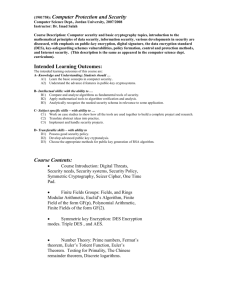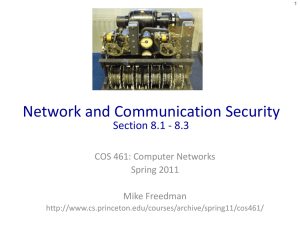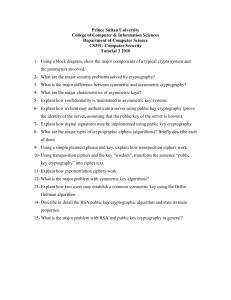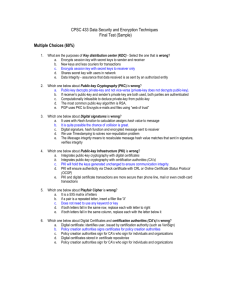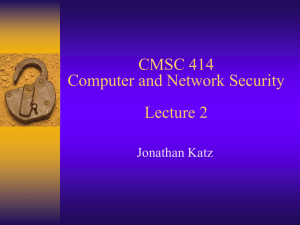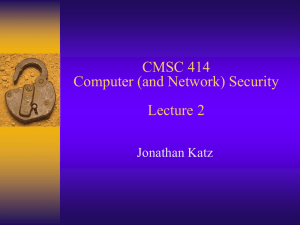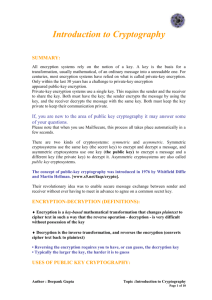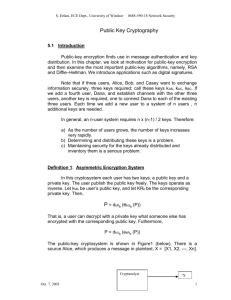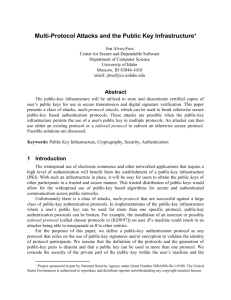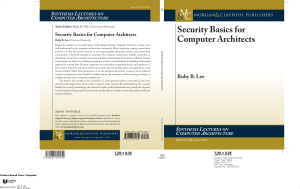索书号:TP309.7-62 /M543 (MIT) HANDBOOK of APPLIED
advertisement
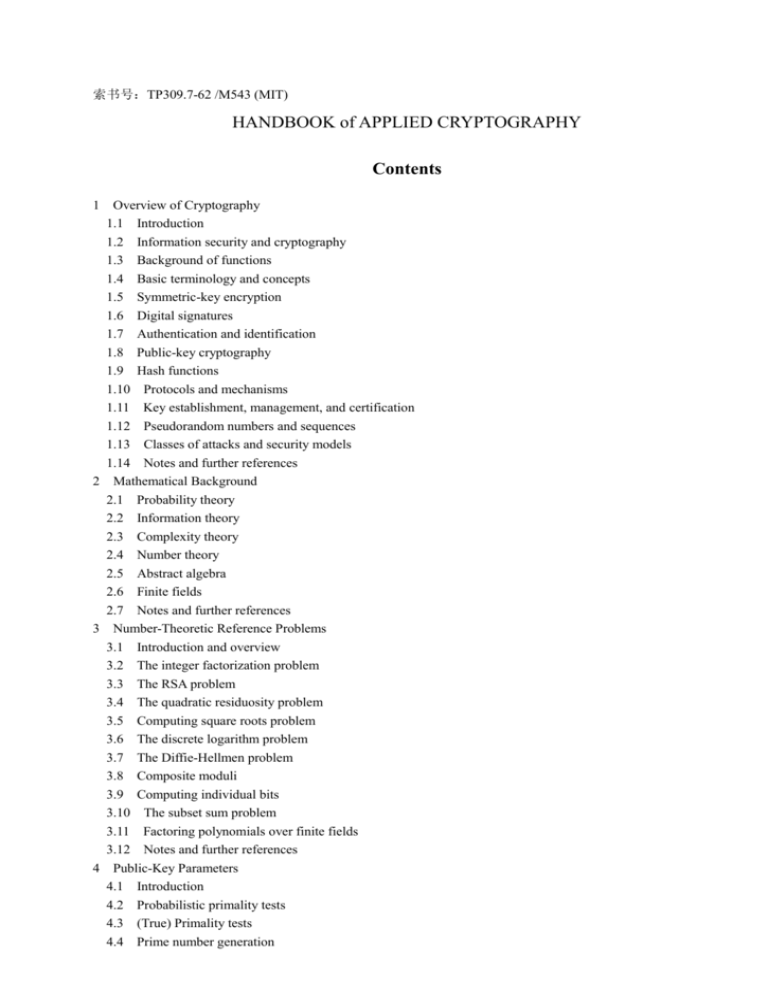
索书号:TP309.7-62 /M543 (MIT) HANDBOOK of APPLIED CRYPTOGRAPHY Contents 1 Overview of Cryptography 1.1 Introduction 1.2 Information security and cryptography 1.3 Background of functions 1.4 Basic terminology and concepts 1.5 Symmetric-key encryption 1.6 Digital signatures 1.7 Authentication and identification 1.8 Public-key cryptography 1.9 Hash functions 1.10 Protocols and mechanisms 1.11 Key establishment, management, and certification 1.12 Pseudorandom numbers and sequences 1.13 Classes of attacks and security models 1.14 Notes and further references 2 Mathematical Background 2.1 Probability theory 2.2 Information theory 2.3 Complexity theory 2.4 Number theory 2.5 Abstract algebra 2.6 Finite fields 2.7 Notes and further references 3 Number-Theoretic Reference Problems 3.1 Introduction and overview 3.2 The integer factorization problem 3.3 The RSA problem 3.4 The quadratic residuosity problem 3.5 Computing square roots problem 3.6 The discrete logarithm problem 3.7 The Diffie-Hellmen problem 3.8 Composite moduli 3.9 Computing individual bits 3.10 The subset sum problem 3.11 Factoring polynomials over finite fields 3.12 Notes and further references 4 Public-Key Parameters 4.1 Introduction 4.2 Probabilistic primality tests 4.3 (True) Primality tests 4.4 Prime number generation 4.5 Irreducible polynomials over Zp 4.6 Generators and elements of high order 4.7 Notes and further references 5 pseudorandom Bits and Sequences 5.1 Introduction 5.2 Random bit generation 5.3 pseudorandom bit generation 5.4 Statistical tests 5.5 Cryptographically secure pseudorandom bit generation 5.6 Notes and further references 6 Stream Ciphers 6.1 Introduction 6.2 Feedback shift registers 6.3 Stream ciphers based on LFSRs 6.4 Other stream ciphers 6.5 Notes and further references 7 Block Ciphers 7.1 Introduction and overview 7.2 Background and general concepts 7.3 Classical ciphers and historical development 7.4 DES 7.5 FEAL 7.6 IDEA 7.8 SAFER, PC5, and other block ciphers 7.9 Notes and further references 8 Public-Key Encryption 8.1 Introduction 8.2 RSA public-key encryption 8.3 Rabin public-key encryption 8.4 ElGamal public-key encryption 8.5 McEliece public-key encryption 8.6 Knapsack public-key encryption 8.7 Probabilistic public-key encryption 8.8 Notes and further references 9 Hash Function and Data Integrity 9.1 Introduction 9.2 Classification and framework 9.3 Basic constructions and general results 9.4 Unkeyed hash functions(MDCs) 9.5 Keyed hash functions(MACs) 9.6 Data integrity and message authentication 9.7 Advanced attacks on hash functions 9.8 Notes and further references 10 Identifications and Entity Authentication 10.1 Introduction 10.2 Passwords (weak authentication) 10.3 Challenge-response identification(strong authentication) 10.4 Customized and zero-knowledge identification protocols 10.5 Attacks on identification protocols 10.6 Notes and further references 11 Digital Signatures 11.1 Introduction 11.2 A framework for digital signature mechanisms 11.3 RSA and related signature schemes 11.4 Fiat-Shamir signature schemes 11.5 The DSA and related signature schemes 11.6 One-time digital signature 11.7 Other signature schemes 11.8 Signature with additional functionality 11.9 Notes and further references 12 Key Establishment Protocols 12.1 Introduction 12.2 Classification and framework 12.3 Key transport based on symmetric encryption 12.4 Key agreement based on symmetric techniques 12.6 Key agreement based on asymmetric techniques 12.7 Secret sharing 12.8 Conference keying 12.9 Analysis of key establishment protocols 12.10 Notes and further references 13 Key Management Techniques 13.1 Introduction 13.2 Background and basic concepts 13.3 Techniques for distributing confidential keys 13.4 Techniques for distributing public keys 13.5 Techniques for controlling key usage 13.6 Key management involving multiple domains 13.7 Key life cycle issues 13.8 Advanced trusted third party services 13.9 Notes and further references 14 Efficient Implementation 14.1 Introduction 14.2 Multiple-precision integer arithmetic 14.3 Multiple-precision modular arithmetic 14.4 Greatest common divisor algorithms 14.5 Chinese remainder theorem for integers 14.6 Exponentiation 14.7 Exponent recoding 14.8 Notes and further references 15 Patents and Standards 15.1 Introduction 15.2 Patents on cryptographic techniques 15.3 Cryptographic standards 15.4 Notes and further references A Bibliography of Papers from Selected Cryptographic Forums A.1 Asiacrypt/Auscrypt Proceedings A.2 Crypto Proceedings A.3 Eurocrypt Proceedings A.4 Fast Software Encryption Proceedings A.5 Journal of Cryptology papers References Index Abstract Cryptography, in particular public-key cryptography, has emerged in the last 20 years as an important discipline that is not only the subject of an enormous amount of research, but provides the foundation for information security in many applications. Standards are emerging to meet the demands for cryptographic protection in most areas of data communications. Public-key cryptographic techniques are now in widespread use in industry, especially in the financial services industry, in the public sector. .And by individuals for their personal privacy, such as in electronic mail. This Handbook will serve as a valuable reference for the novice as for the expert who needs a wider scope of coverage within the area of cryptography. It is a necessary and timely guide for professionals who practice the art of cryptography.
